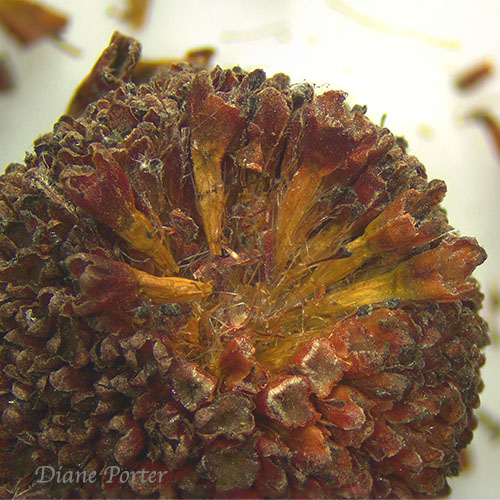Buttonbush and its Seeds
Fuzzy Balls

I first saw blooming Buttonbush at Neff Wetlands, a reconstructed wetland near Lamson Woods. I couldn't get close to it, surrounded by tall other plants and water. But it was love at first sight.
I wanted Buttonbush growing on my own land. It's primarily a wetland plant, and I have a pond but not really a wetland. It was not clear to me where it would grow well for me. But the next year, a friend gave me six leftover seedlings, conservation stock from the Iowa Department of Natural Resources.
I planted four of them within a few feet of the pond and resolved to water them faithfully.
We were in the thick of a drought, and the pond had shrunk, leaving a wide band of exposed mud. I'd read that Buttonbush likes damp feet and doesn't object to standing water. So I planted my last two seedlings right in the mud at water's edge. I didn't really expect them to do well when the pond filled again, but, well, it was an experiment.
Despite my efforts to provide sufficient water through a punishingly dry summer, the four solid-ground Buttonbushes did not thrive. By fall they were smaller than they'd been when I planted them.

Alive in the water
The following spring, rain and melting snow restored the pond to its original boundary. By summer I realized that the two Buttonbushes I'd planted in the pond were putting up new growth, right through the water, which was by now two feet deep.
They grew slowly. Each year I locating them again, as they continued to put up additional stems and branches. This year, four years after planting, they bloomed for me. They were covered with soft, fluffy-looking white pompons.
After the pretty pompons passed, the seed heads contracted to small green balls, the width of the tip of my index finger. They stayed green for months, and I wondered if they had made seeds. I put organza drawstring bags around a few of the balls, to make sure I could collect some seeds if there were any. And I waited.

Grandmother's sachet ball
Not until October did the seed heads finally turn brown. When at last I collected them, it was not obvious where the seeds were. So I put one of the balls under the microscope for a closer look. I poked at a brown seed head with sharp tweezers. The ball loosened, and I saw the seeds. They were packed together, tips toward the center.
My grandmother used to push closely spaced cloves into an orange and let it dry until it became a fragrant sachet. The Buttonbush seeds reminded me of those cloves, the way they fit so neatly that they formed a solid sphere.
Architecture of the seed

The part that contains the seed is slender, about 2 millimeters long and yellowish in color. At the top end, a brownish structure is the calyx, which formed the base of the flower when it was blooming.
In this plant, the seed forms below the calyx. Botanists take a certain pleasure in referring to this architecture as an inferior ovary. Inferior in the sense of below. That is, the seeds form below the petals and calyx.
I've been told by a botanist who knows far more than I do that the yellow structure contains two seeds. I find it difficult to open it up and see for myself, as this is tiny thing. It usually flies away from my tweezers and scalpel, to disappear into a crevice in the furniture. If I ever succeed in getting a good look at the hidden seeds, I'll post a photo here.
Buttonbush is a native wildflower of eastern North America and Central America. It attracts hummingbirds and many kinds of beneficial insects. Its scientific name is Cephalanthus occidentalis.
— Diane Porter, Fairfield, Iowa, November 10, 2021
See more of Diane's blogposts about plants

